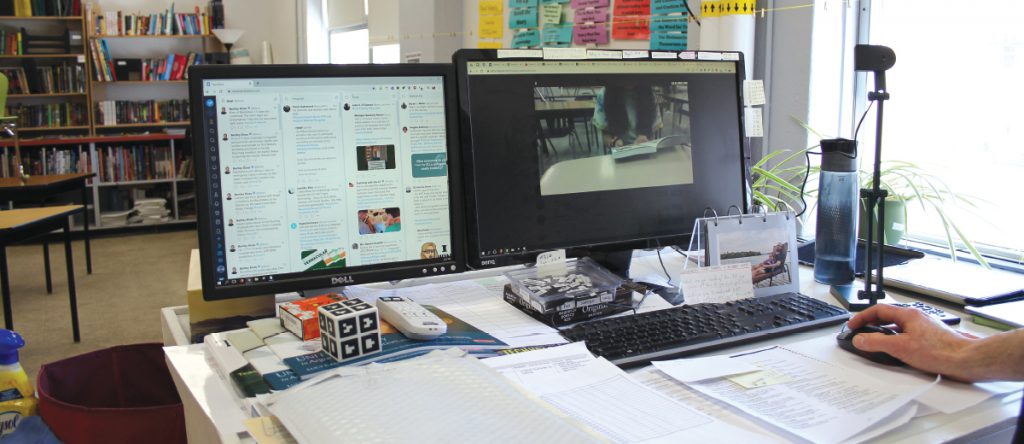Break Plan Gets Failing Grade
Education Minister Kelvin Goertzen announced today that the province will be mandating a two-week remote learning period for Grades 7 to 12 students, beginning January 4, 2021. Optional remote learning will be available to kindergarten to Grade 6 students during this period.
“Recovery learning has been a challenge this year so we support that there is no interruption in instruction,” said MTS President James Bedford. “However if the intent is to reduce transmission of COVID-19 following the holidays then all schools should be going to Code Red for two weeks.”
Bedford said The Society made this recommendation to the government when the idea about extending the break was first floated and is disappointed with this plan.
“This is yet another half measure approach and I fail to see how this plan enhances the safety of students and teachers when half the grades are in school for those two weeks,” he said. “Teachers and other staff are also members of the community and not immune to the holiday gathering transmission the province is trying to minimize.”
Bedford said The Society is concerned about the government’s failure to act on its recommendation to make masks mandatory for those in kindergarten to Grade 3, a measure that would enhance school safety by adding another layer of protection, especially following the holiday season and among students who cannot physically distance.
“The minister keeps passing the buck and saying the public health officer doesn’t see the need for masks in the younger grades, but the government has been slow to provide any real evidence about transmission rates in schools,” said Bedford. “Saying that schools are safe is no longer good enough. We want proof and in the absence of proof common sense and best practice should prevail.”
Bedford said teachers are already struggling with heavy workloads, and the optional remote learning for K-6 students means more teachers may have to teach remotely as well as in the classroom. This has the potential to cause further disruption to class composition and cohorts. It also forces teachers to plan and re-plan for changing school attendees when new parents opt for remote learning just for those two weeks.
“Teachers are burning out. This is a fact. We see it reflected in the high numbers of members accessing our counselling services and our disability and benefits plan,” said Bedford. “This plan places unreasonable demands on teachers and runs the risk of collapsing the entire education system when teachers buckle under the pressure.”
While the government points to the remote learning centre as a solution for teacher workload, Bedford said The Society is still unclear as to the role of the centre.
“We keep hearing about this remote learning centre that is supposed to solve all the problems with workload, but we still don’t know how,” he said. “To date, the province has hired 20 of the 140 staff to run this remote learning centre. With the break approaching, we are quickly running out of time.”
Bedford said that there is an easy solution for dealing with teacher workload and helping to minimize the spread of the coronavirus.
“If all students are receiving remote instruction for this period, these issues are resolved,” said Bedford.
The two-week period runs from January 4 to 15th.
Plan for Safe Schools Fund
In an effort to further protect schools, the provincial government is confirming the full allocation of the Safe Schools Fund, Education Minister Kelvin Goertzen announced today.
The $100-million Safe Schools Fund, established in August, included $48 million in school division savings from the 2019-20 school year and an additional $52 million in provincial funding. In late August, the federal government also announced $85.4 million in COVID-related funding for education. This total pool of $185.4 million will be used to augment staffing, health and safety, learning and technology.
James Bedford, president of The Manitoba Teachers’ Society, says this announcement is long overdue.
“We have been calling on the province and federal government to release these funds for some time now,” Bedford said. “So far only $15 million of the federal funds have been distributed, province wide. While we have been waiting, our schools and our teachers have been bending to the point of breaking.”
The confirmed allocations to support schools include $76 million per pupil allocations for school divisions and independent schools including $44 million to specifically address staffing needs, and a $39.4 million Safe Restart Contingency Fund, which is application-based funding to support emerging needs.
School divisions and independent schools will be able to apply for additional funding for needs not covered by their Safe Schools allocation through the Safe Restart Contingency Fund. The contingency fund will cover incremental expenditures to meet health and safety requirements, address extenuating public health conditions in the region/area that may entail unique cost pressures, and support innovative approaches that may support outcomes for a broader school community, region or the province as a whole.
Goertzen said staffing is a key component of the government’s COVID-19 education measures. School divisions continue to recruit additional teachers, educational assistants, substitute teachers, custodial staff, bus drivers, clinicians and other critical staff, he added. As of Oct. 31, more than $9 million has been invested in additional staffing, with a total investment of more than $67 million already projected to be spent by June 2021.

